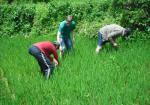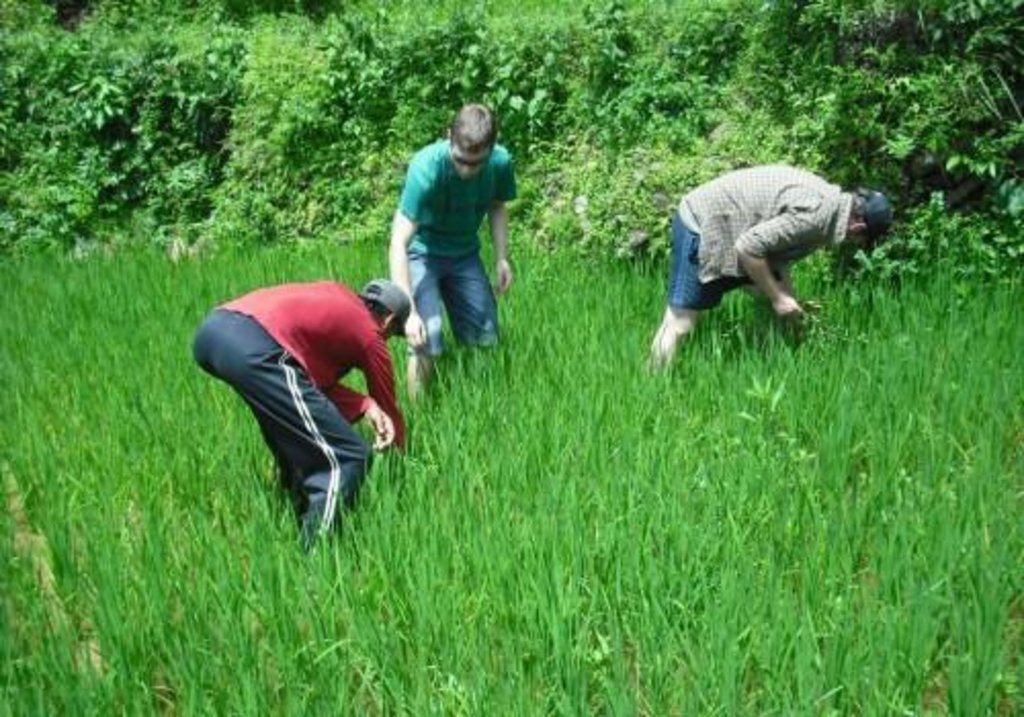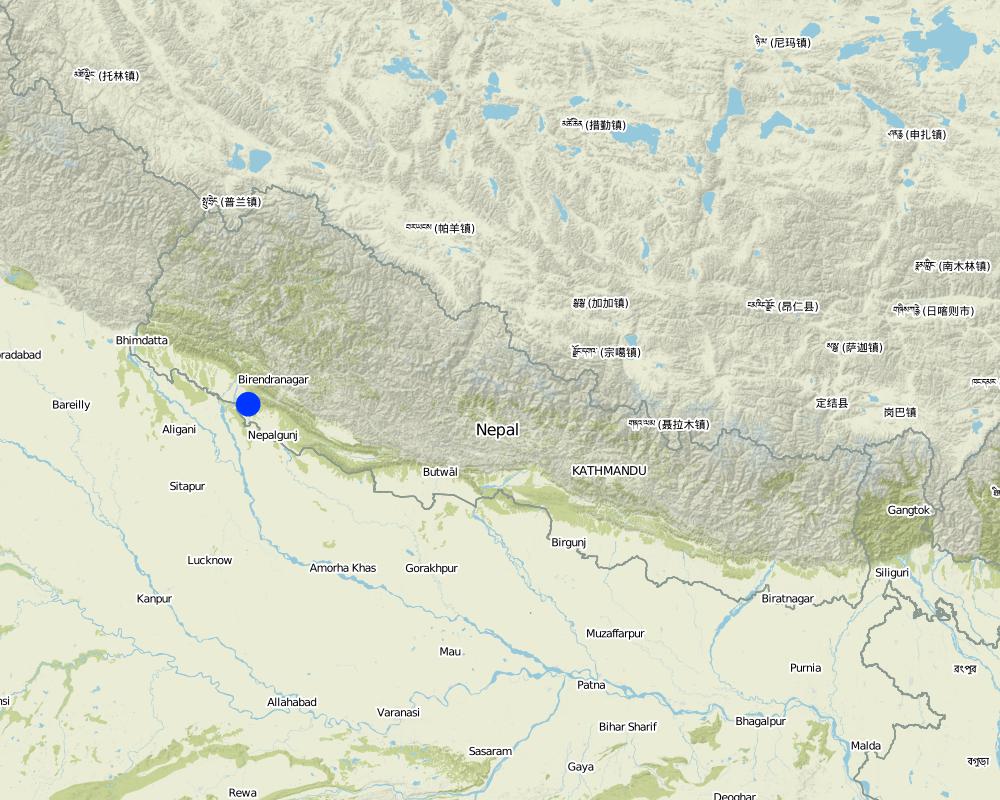Promotion of Sesbania species(as green manures for rice cultivation) [Nepal]
- Creation:
- Update:
- Compiler: Sabita Aryal
- Editor: –
- Reviewer: Fabian Ottiger
Dhaincha Prabardhan
approaches_2483 - Nepal
View sections
Expand all Collapse all1. General information
1.2 Contact details of resource persons and institutions involved in the assessment and documentation of the Approach
SLM specialist:
Acharya Shiva
Local farmer Gumi-3 Surkhet,Nepal
Nepal
SLM specialist:
Regmi Dambar
Local farmer Gumi-3 Surkhet,Nepal
Nepal
SLM specialist:
Gurung Thek
Local farmer Gumi-4, Surkhet,Nepal
Nepal
Name of the institution(s) which facilitated the documentation/ evaluation of the Approach (if relevant)
Kathmandu University (KU) - Nepal1.3 Conditions regarding the use of data documented through WOCAT
The compiler and key resource person(s) accept the conditions regarding the use of data documented through WOCAT:
Yes
2. Description of the SLM Approach
2.1 Short description of the Approach
Green manure-It is a way of adding nutrients and organic matters to soil by incorporating green manure plants which include both leguminous or non-leguminous plants. Sesbania, also known as Dhaincha, i.e. a diverse and versatile genus belonging to the family Fabaceae,which is soft,woody,annual or short lived perennial;primarily used as green manure between rice crops or as an intercrop in transplanted rice.
2.2 Detailed description of the Approach
Detailed description of the Approach:
Aims / objectives: -Leguminous green plants like Sesbania can fix atmospheric nitrogen in the form that plant can use.
-It helps to improve the soil structure as incorporating it into the soil adds organic matterr (biomass).
-The Sesbania species has high water-logging tolerance which prevents the crop from losing its nutrient content.
Methods: In nepal,institutions like NARC and research programs like Rice Research program has actively promoted Sesbania species. Dr. Bhola man singh basnet of Nepal Agriculture Research council(NARC),khumaltar has extensively carried out his research on green manure using Sesbania, which is called locally as Dhaincha.
The Hardinath Agriculture Farm in Dhanusha,now National Rice Research Program, practiced Sesbania cannabina, dhaincha as pre-rice manure annually in 20 ha for more than 20 years.
Green manure technique is an indigenous practice mainly in the foothills, middle mountains region and central terai of nepal-dhanusha,parsa,bara and Rautahat district.
Stages of implementation: Sesbania is sown before rice is planted.Sow the Sesbania seed densly and lightly cover the seed with soil.Sesbania will grow faster if the soil is kept moist.After 4-6 weeks sesbania will be 18-36 inches tall at ground level and plough in as the paddy are prepared for planting rice.
Seed production process;
Transplant a few of the largest,thickest,healthiest plant into the edges of paddy space at 2 metre intervals along the terrace edges.Seed will be ready after 6 -7 months.This can be used as seed for green manure next year.
Role of stakeholders: Government;
-Institutional roles; NARC, HAF -DDC-Municipality-VDC
Private sectors;
-Desigining policies.
Other important information: -Sesbania species can be grown even under adverse conditions of drought,waterlogging,salinity,etc.
-optimum time of Daincha seed production is the middle of March until the end of May .
-Experiment conducted at several research stataions showed that green manureing with dhaincha in rice increased the grain yields by about 20-25 percent(Pre rice green manure-a success story,B.H.S Basnet,NARC)
2.3 Photos of the Approach
2.5 Country/ region/ locations where the Approach has been applied
Country:
Nepal
Region/ State/ Province:
Nepal
Further specification of location:
Surkhet
Map
×2.7 Type of Approach
- traditional/ indigenous
2.8 Main aims/ objectives of the Approach
The Approach focused mainly on SLM with other activities (Sesbania species increases nutrient content of the soil,due to its water logging tolerance and also increases the fertility,biomass production in the fields as well as nitrogen content of the soil by fixing large amount of Nitrogen.)
-Increase the nutrient in the soil due to its water logging tolerance and thus increases the fertility and productivity.
-Also reduce the need of artificial fertilizers
The SLM Approach addressed the following problems: Low knowledge about the green manuring among people because of which they were lured towards more use of particles and fertilizers.
Lack of improved seeds of green manure(plants).
2.9 Conditions enabling or hindering implementation of the Technology/ Technologies applied under the Approach
availability/ access to financial resources and services
- hindering
-Improved and large seeds of green manure are costly.
-This can be reduced if we can make these seed locally available at subsidized rate.
Treatment through the SLM Approach:
legal framework (land tenure, land and water use rights)
- enabling
The existing land ownership, land use rights / water rights moderately helped the approach implementation: There was a bit hindrance.Seed cultivation requires both land use and irrigation system.
knowledge about SLM, access to technical support
- hindering
-People were found unaware of the proper and new techniques of manuring.
Treatment through the SLM Approach: -Provide necessary information and conduct programs at local/regional level.
other
- hindering
The species shows better growth and higher biomass yield in the sandy clay than in heavy clay soil.
Treatment through the SLM Approach: The areas with sandy clay loam should be identified if we are to except a high crop yield.
3. Participation and roles of stakeholders involved
3.1 Stakeholders involved in the Approach and their roles
- local land users/ local communities
Farmers community
Men were involved more, because of the hard work in the field.. Many people are using the green manure technique to increase the crop yield but no any incentives and support has been provided by government institutions targeting the socially and economically disadvantaged groups.
- local government
Hierarchy;District Development comittee-Municipality-VDC
- national government (planners, decision-makers)
Ministry of agriculture
3.2 Involvement of local land users/ local communities in the different phases of the Approach
| Involvement of local land users/ local communities | Specify who was involved and describe activities | |
|---|---|---|
| initiation/ motivation | self-mobilization | Farmers |
| planning | interactive | Involvement of individuals (farmers) at the begining.Gradually supported by many institutions. |
| implementation | self-mobilization | Sesbania is a local species available in Nepal since 1960 and used as green manure by farmers land users to increase productivity and field of crops. |
| monitoring/ evaluation | passive | Gradual progress and support from government and institutions. |
| Research | external support | Research being carried by institutions, on nutrient content and new species of green manure plant. |
3.4 Decision-making on the selection of SLM Technology/ Technologies
Specify who decided on the selection of the Technology/ Technologies to be implemented:
- mainly land users, supported by SLM specialists
Explain:
Green manuring using Dhaincha is an indigenous practice which is currently supported and motivated by many institutions.
Decisions on the method of implementing the SLM Technology were made by by land users* alone (self-initiative / bottom-up). Due to the dissatisfaction by the use of the fertilizers(artifical) land users themselves initiated the approach for better production.
4. Technical support, capacity building, and knowledge management
4.1 Capacity building/ training
Was training provided to land users/ other stakeholders?
No
4.2 Advisory service
Do land users have access to an advisory service?
Yes
Describe/ comments:
Name of method used for advisory service: Participatory community-based approach.; Many people including farmers, land users participate,discuss and conclude about the way of practicing of green manuring.
Advisory service is quite adequate to ensure the continuation of land conservation activities; Government and institution are the one that make the seeds of green manure plant available to the local farmers.So their contribution and continuation of land conservation activities cannot be neglected.
4.3 Institution strengthening (organizational development)
Have institutions been established or strengthened through the Approach?
- yes, moderately
Specify the level(s) at which institutions have been strengthened or established:
- local
Specify type of support:
- capacity building/ training
Give further details:
Documentation of the approach provide training to the land users about green manure techniques.
4.4 Monitoring and evaluation
Is monitoring and evaluation part of the Approach?
Yes
Comments:
bio-physical aspects were regular monitored by government through observations; indicators: Nutrients like N,P,K are monitered at a regular basis by and institutioons like NARC,HAF.government land users(farmers)
economic / production aspects were regular monitored by land users through observations; indicators: crop yield per hectare.
There were few changes in the Approach as a result of monitoring and evaluation: seed varities of sesbian species shows better growth in sandy clay than heavy clay soil. so, the soil type needs to be considered.
4.5 Research
Was research part of the Approach?
Yes
Specify topics:
- ecology
Give further details and indicate who did the research:
Research was carried out on-farm
5. Financing and external material support
5.1 Annual budget for the SLM component of the Approach
If precise annual budget is not known, indicate range:
- < 2,000
5.2 Financial/ material support provided to land users
Did land users receive financial/ material support for implementing the Technology/ Technologies?
Yes
If yes, specify type(s) of support, conditions, and provider(s):
Governmental Aid.
5.3 Subsidies for specific inputs (including labour)
Comments:
Green manure seeds are distributed by the government to the local bodies;from where the seeds are sold to the land users/farmers.
5.4 Credit
Was credit provided under the Approach for SLM activities?
Yes
6. Impact analysis and concluding statements
6.1 Impacts of the Approach
Did the Approach help land users to implement and maintain SLM Technologies?
- No
- Yes, little
- Yes, moderately
- Yes, greatly
- it increases the fertility and nutrient content of the soil due to its water logging tolerance. -Helps control soil erosion. -It also improve the quality of soil and crops.
Did the Approach empower socially and economically disadvantaged groups?
- No
- Yes, little
- Yes, moderately
- Yes, greatly
Poor farmers earn quite a good sum due to increase in yield and productivity by using sesbania as green manure.
The problem is likely to be overcome in the near future.
Did other land users / projects adopt the Approach?
- No
- Yes, little
- Yes, moderately
- Yes, greatly
NARC which provide training as well as focus on the practice of green manuring which help all the villagers to get benefitted.
Did the Approach lead to improved livelihoods / human well-being?
- No
- Yes, little
- Yes, moderately
- Yes, greatly
using sesbania species as green manure increases the production of rice in the farms. also reduce the expenses for buying of artificial fertilizers from suppliers.
Did the Approach help to alleviate poverty?
- No
- Yes, little
- Yes, moderately
- Yes, greatly
increase the productivity and crop yield which lead to the rise in economic status of people by selling the grains on market.
6.2 Main motivation of land users to implement SLM
- increased production
increase in the crop productivity.
6.3 Sustainability of Approach activities
Can the land users sustain what has been implemented through the Approach (without external support)?
- yes
If yes, describe how:
Since it is easy and natural method to increase the fertility of the soil,farmers can be benifited..it only requires the basic knowledge about the seasons and seeds(improved) so it can be easily implemented.
6.4 Strengths/ advantages of the Approach
| Strengths/ advantages/ opportunities in the land user’s view |
|---|
|
-if some species of sesbina like Sesbania cannabina are established as an intercrop in rice. -During short Day season,vegetative growth of the plant is reduced due to early flowering. -Many Sesbania species are being over ploited. -Improved seeds of sesbian sp, are costly and this technique requires a lot of labour work, people are in more favour of artificial chemical fertilizers. (How to sustain/ enhance this strength: -it can be suppressed by the rice if sown 30-60 days after crop. -These sp. should be sowed in the middle of March to end of vegetables growth. -Attention must be given to the conservation and proper utilization of these important plant species. -Government /local bodies should make it available at cheaper rate and encourage people to revive interest in green manures.) |
| Strengths/ advantages/ opportunities in the compiler’s or other key resource person’s view |
|---|
|
-Increase the fertility of the soil. -it can help to increase the biomass in the soil. -Increases microorganisms and their activity in the soil. (How to sustain/ enhance this strength: They can be enhanced if the present trend of exploiting green manuring plants are changed to develop their production on a sustainable basis.) |
7. References and links
7.1 Methods/ sources of information
- field visits, field surveys
- interviews with land users
7.2 References to available publications
Title, author, year, ISBN:
Regenerative Agriculture Technologies for the Hill farmers of Nepal,'Nepal Rural Re-construction Association.The Farmers Handbook,'The Field' Ms. Hommaya GurungGreen Manure Production System For Asian Ricelands, J.K Ladha
Links and modules
Expand all Collapse allLinks
No links
Modules
No modules





